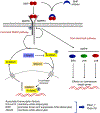Beyond the bone: Bone morphogenetic protein signaling in adipose tissue
- PMID: 30609449
- PMCID: PMC6447448
- DOI: 10.1111/obr.12822
Beyond the bone: Bone morphogenetic protein signaling in adipose tissue
Abstract
The bone morphogenetic proteins (BMPs) belong to the same superfamily as related to transforming growth factor β (TGFβ), growth and differentiation factors (GDFs), and activins. They were initially described as inducers of bone formation but are now known to be involved in morphogenetic activities and cell differentiation throughout the body, including the development of adipose tissue and adipogenic differentiation. BMP4 and BMP7 are the most studied BMPs in adipose tissue, with major roles in white adipogenesis and brown adipogenesis, respectively, but other BMPs such as BMP2, BMP6, and BMP8b as well as some inhibitors and modulators have been shown to also affect adipogenesis. It has become ever more important to understand adipose regulation, including the BMP pathways, in light of the strong links between obesity and metabolic and cardiovascular disease. In this review, we summarize the available information on BMP signaling in adipose tissue using preferentially articles that have appeared in the last decade, which together demonstrate the importance of BMP signaling in adipose biology.
Keywords: adipogenesis; bone morphogenetic protein (BMP); obesity.
© 2019 World Obesity Federation.
Figures


Similar articles
-
Bone morphogenetic proteins.Growth Factors. 2004 Dec;22(4):233-41. doi: 10.1080/08977190412331279890. Growth Factors. 2004. PMID: 15621726 Review.
-
Potential Functions of the BMP Family in Bone, Obesity, and Glucose Metabolism.J Diabetes Res. 2021 Jun 23;2021:6707464. doi: 10.1155/2021/6707464. eCollection 2021. J Diabetes Res. 2021. PMID: 34258293 Free PMC article. Review.
-
BMP4 and BMP Antagonists Regulate Human White and Beige Adipogenesis.Diabetes. 2015 May;64(5):1670-81. doi: 10.2337/db14-1127. Epub 2015 Jan 20. Diabetes. 2015. PMID: 25605802
-
Oocyte-somatic cell interactions in the human ovary-novel role of bone morphogenetic proteins and growth differentiation factors.Hum Reprod Update. 2016 Dec;23(1):1-18. doi: 10.1093/humupd/dmw039. Epub 2016 Oct 26. Hum Reprod Update. 2016. PMID: 27797914 Free PMC article. Review.
-
Adipose tissue plasticity and the pleiotropic roles of BMP signaling.J Biol Chem. 2021 Jan-Jun;296:100678. doi: 10.1016/j.jbc.2021.100678. Epub 2021 Apr 17. J Biol Chem. 2021. PMID: 33872596 Free PMC article. Review.
Cited by
-
Preparation of Coralline Hydroxyapatite Implant with Recombinant Human Bone Morphogenetic Protein-2-Loaded Chitosan Nanospheres and Its Osteogenic Efficacy.Orthop Surg. 2020 Dec;12(6):1947-1953. doi: 10.1111/os.12752. Epub 2020 Oct 20. Orthop Surg. 2020. PMID: 33080108 Free PMC article.
-
Advanced PLGA hybrid scaffold with a bioactive PDRN/BMP2 nanocomplex for angiogenesis and bone regeneration using human fetal MSCs.Sci Adv. 2021 Dec 10;7(50):eabj1083. doi: 10.1126/sciadv.abj1083. Epub 2021 Dec 8. Sci Adv. 2021. PMID: 34878837 Free PMC article.
-
Expression of genes involved in neurogenesis, and neuronal precursor cell proliferation and development: Novel pathways of human ovarian granulosa cell differentiation and transdifferentiation capability in vitro.Mol Med Rep. 2020 Apr;21(4):1749-1760. doi: 10.3892/mmr.2020.10972. Epub 2020 Jan 31. Mol Med Rep. 2020. PMID: 32319615 Free PMC article.
-
Navigating the Adipocyte Precursor Niche: Cell-Cell Interactions, Regulatory Mechanisms and Implications for Adipose Tissue Homeostasis.J Cell Signal. 2024;5(2):65-86. doi: 10.33696/signaling.5.114. J Cell Signal. 2024. PMID: 38826152 Free PMC article.
-
Obesity Impairs Embryonic Myogenesis by Enhancing BMP Signaling within the Dermomyotome.Adv Sci (Weinh). 2021 Nov;8(22):e2102157. doi: 10.1002/advs.202102157. Epub 2021 Oct 14. Adv Sci (Weinh). 2021. PMID: 34647690 Free PMC article.
References
-
- Kelly T, Yang W, Chen CS, Reynolds K, He J. Global burden of obesity in 2005 and projections to 2030. Int J Obes. 2008; 32: 1431–7. - PubMed
-
- Wang Y, Beydoun MA, Liang L, Caballero B, Kumanyika SK. Will all Americans become overweight or obese? estimating the progression and cost of the US obesity epidemic. Obesity. 2008; 16: 2323–30. - PubMed
-
- Brondani LA, Assmann TS, Duarte GC, Gross JL, Canani LH, Crispim D. The role of the uncoupling protein 1 (UCP1) on the development of obesity and type 2 diabetes mellitus. Arq Bras Endocrinol Metabol. 2012; 56: 215–25. - PubMed
Publication types
MeSH terms
Substances
Grants and funding
LinkOut - more resources
Full Text Sources

